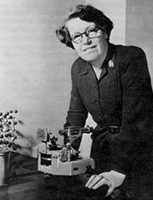Helen Megaw
Helen Megaw | |
|---|---|
 Megaw circa 1950 | |
| Born | 1 June 1907 |
| Died | 26 February 2002 (aged 94) |
| Nationality | Irish |
| Alma mater | Queen's University, Belfast, Girton College |
| Known for | Crystallographer who determined the structure of ice crystals and the Perovskite crystal structure. |
| Awards | The Roebling Medal of the Mineralogical Society of America. Megaw Island and the mineral (CaSnO3) are named after her. |
| Scientific career | |
| Thesis | (1934) |
| Doctoral advisor | J. D. Bernal |
Helen Dick Megaw (1 June 1907 – 26 February 2002)[1] was an Irish crystallographer who was a pioneer in X-ray crystallography.[2] She made measurements of the cell dimensions of ice and established the Perovskite crystal structure.
Education and career[]
Megaw was born in Dublin and educated there and at Rodean. While still at school, Megaw read Bragg's X-rays and Crystal Structure.[2] She spent a year Queen's University, Belfast[2] before moving to Girton College, Cambridge to study Natural Sciences in 1926. She graduated in 1930 and was a research student in crystallography under J. D. Bernal.[2] Megaw's first speciality was the structure of ice, and she was awarded her PhD in 1934,[3] and Girton awarded her a Hertha Ayrton research scholarship which she used to study in Vienna in 1934-1935 under Hermann Francis Mark. In 1935 Megaw co-published with Bernal an influential method for fixing the position of hydrogen atoms known as the Bernal-Megaw model.[2] She spent the year 1935-1936 in Oxford with Francis Simon[2] and then spent several years as a schoolteacher before becoming an industrial crystallogropher with Philips Lamps in London in 1943. It was through work at Philips on barium titanate that Megaw first worked on the perovskite crystal structure, on which she established herself as an acknowledged expert.[2] In 1945 Megaw returned to working with Bernal, now at Birkbeck College in London, for a year before taking a post at the Cavendish Laboratory in Cambridge. She became a Fellow and Director of Studies at Girton. Megaw retired in 1972 and divided her time between Cambridge and Ballycastle, County Antrim, where she died in 2002.[2]
Her first book, Ferroelectricity in Crystals, was published in 1957.[2] It was followed by a second book, Crystal Structures: a Working Approach, in 1973.[3]
Following a conversation with Mark Hartland Thomas in 1949 (chief industrial officer of the Council of Industrial Design), Megaw was appointed scientific consultant for the of the Festival of Britain, 1951. She became the prime scientific mover in the group which put crystallographic images in the hands of industrial designers for them to use in products which were displayed at the Festival and in some cases beyond.[4][5] In 2019, some of Megaw's fabric samples were displayed at the Science Museum, London as part of an exhibition "The Art of Innovation" [6]which explored the relationship between art and science.
Legacy and honors[]
In recognition of her work in determining the structures of ice crystals, Megaw Island in the Southern Ocean is named for her.[7] (CaSnO3), a perovskite-group mineral, is also named after her.[8]
In 1976, Megaw gave a collection of fabric samples from the Festival of Britain along with a souvenir guide-book to the Science Museum in London.
In 1989, Megaw became the first woman to receive the Roebling Medal of the Mineralogical Society of America. She had honorary doctorates from the Universities of Cambridge and Queen's University Belfast.[2]
References[]
- ^ A. M. Glazer, "Megaw, Helen Dick (1907–2002)", Oxford Dictionary of National Biography doi:10.1093/ref:odnb/76773
- ^ Jump up to: a b c d e f g h i j "Helen Dick Megaw (1907 - 2002): Mineralogist". The Dictionary of Ulster Biography. Retrieved 2012-10-20.
- ^ Jump up to: a b Personal papers of Helen Megaw
- ^ Lesley., Jackson (2008). From atoms to patterns : crystal structure designs from the 1951 Festival of Britain : the story of the Festival Pattern Group. Wellcome Collection. Shepton Beauchamp: Richard Dennis. ISBN 978-0955374111. OCLC 226282421.
- ^ Lomas, Elizabeth (2001). Guide to the Archive of Art and Design, Victoria & Albert Museum. Taylor & Francis. ISBN 9781579583156.
- ^ Blatchford, Ian; Blyth, Tilly (2019). The Art of Innovation. Transworld. pp. 216–225. ISBN 9781787632493.
- ^ "Helen Megaw at the Contributions of 20th Century Women to Physics site". Archived from the original on October 6, 2016.
- ^ Galuskin, E. V.; Galuskina, I. O.; Gazeev, V. M.; Dzierżanowski, P.; Prusik, K.; Pertsev, N. N.; Zadov, A. E.; Bailau, R.; Gurbanov, A. G. (October 2011). "Megawite, CaSnO3: a new perovskite-group mineral from skarns of the Upper Chegem caldera, Kabardino-Balkaria, Northern Caucasus, Russia". Mineralogical Magazine. 75 (5): 2563–2572. Bibcode:2011MinM...75.2563G. doi:10.1180/minmag.2011.075.5.2563.
External Links[]
- 1907 births
- 2002 deaths
- 20th-century Irish scientists
- 21st-century Irish scientists
- 20th-century women scientists
- 21st-century women scientists
- Irish chemists
- Irish women chemists
- Crystallographers
- Alumni of Girton College, Cambridge
- Fellows of Girton College, Cambridge
- People from Dublin (city)